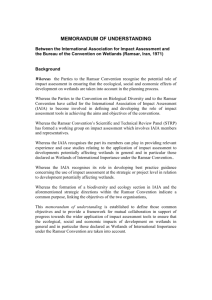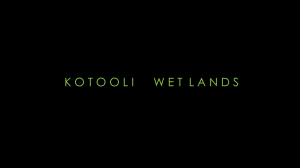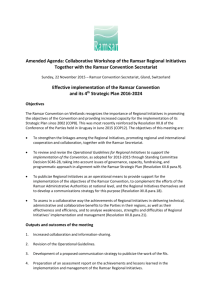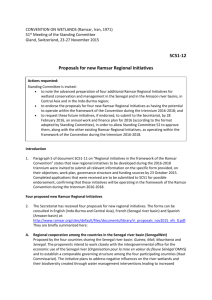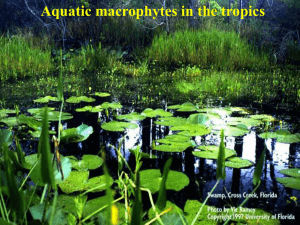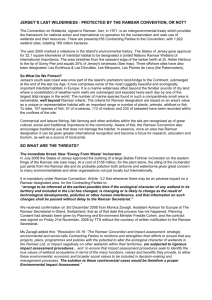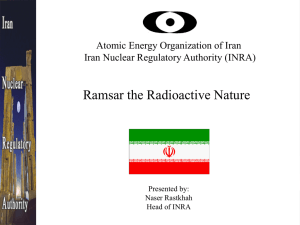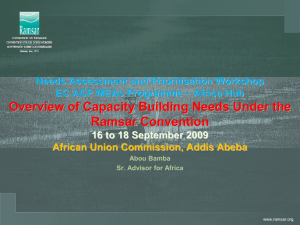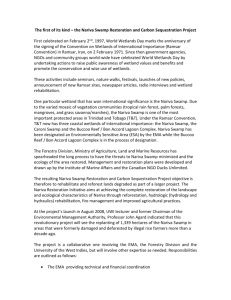Flora and Fauna Guarantee Act 1988 (Vic)
advertisement
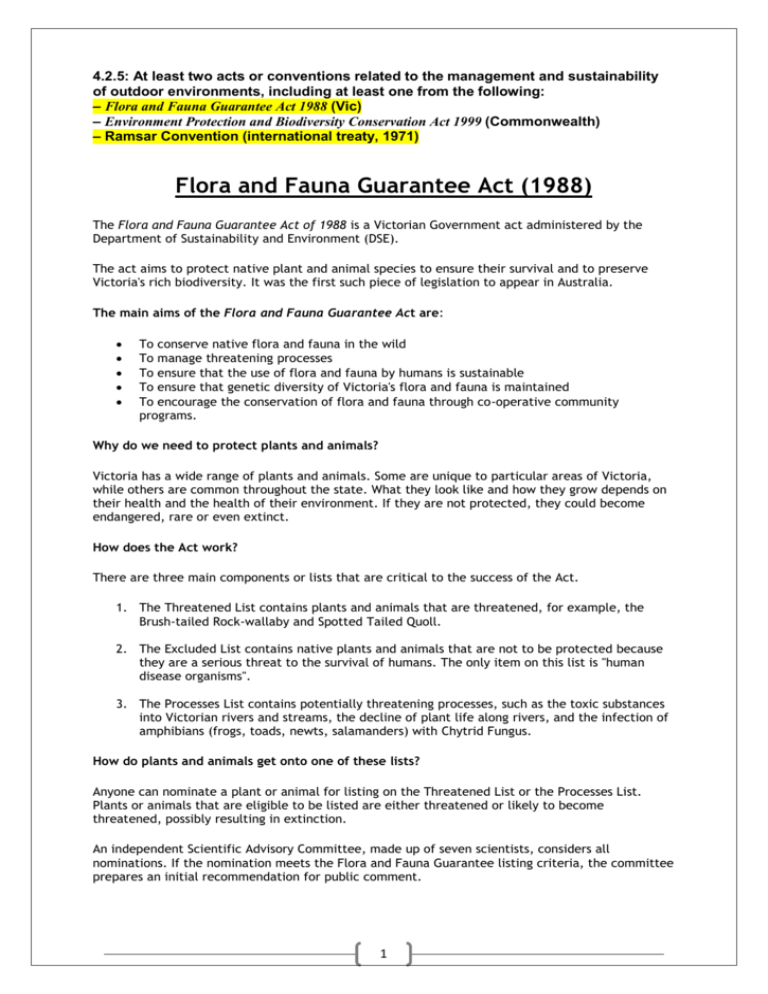
4.2.5: At least two acts or conventions related to the management and sustainability of outdoor environments, including at least one from the following: – Flora and Fauna Guarantee Act 1988 (Vic) – Environment Protection and Biodiversity Conservation Act 1999 (Commonwealth) – Ramsar Convention (international treaty, 1971) Flora and Fauna Guarantee Act (1988) The Flora and Fauna Guarantee Act of 1988 is a Victorian Government act administered by the Department of Sustainability and Environment (DSE). The act aims to protect native plant and animal species to ensure their survival and to preserve Victoria's rich biodiversity. It was the first such piece of legislation to appear in Australia. The main aims of the Flora and Fauna Guarantee Act are: To conserve native flora and fauna in the wild To manage threatening processes To ensure that the use of flora and fauna by humans is sustainable To ensure that genetic diversity of Victoria's flora and fauna is maintained To encourage the conservation of flora and fauna through co-operative community programs. Why do we need to protect plants and animals? Victoria has a wide range of plants and animals. Some are unique to particular areas of Victoria, while others are common throughout the state. What they look like and how they grow depends on their health and the health of their environment. If they are not protected, they could become endangered, rare or even extinct. How does the Act work? There are three main components or lists that are critical to the success of the Act. 1. The Threatened List contains plants and animals that are threatened, for example, the Brush-tailed Rock-wallaby and Spotted Tailed Quoll. 2. The Excluded List contains native plants and animals that are not to be protected because they are a serious threat to the survival of humans. The only item on this list is "human disease organisms". 3. The Processes List contains potentially threatening processes, such as the toxic substances into Victorian rivers and streams, the decline of plant life along rivers, and the infection of amphibians (frogs, toads, newts, salamanders) with Chytrid Fungus. How do plants and animals get onto one of these lists? Anyone can nominate a plant or animal for listing on the Threatened List or the Processes List. Plants or animals that are eligible to be listed are either threatened or likely to become threatened, possibly resulting in extinction. An independent Scientific Advisory Committee, made up of seven scientists, considers all nominations. If the nomination meets the Flora and Fauna Guarantee listing criteria, the committee prepares an initial recommendation for public comment. 1 After a minimum of 30 days, the committee reconsiders the recommendation in the light of any further evidence and public comment presented. Finally, the committee makes a recommendation to the Minister for Environment and Climate Change, who can then add or remove a listing by regulation. Since the introduction of the act, more than 300 Victorian plant and animal species have been listed as endangered. What happens after a plant or animal is listed? The Department of Sustainability and Environment prepares an action statement for each plant or animal as soon as possible after it is listed. Action statements are like brief management plans. They provide information and outline what actions are required to protect the species. The DSE website has a good list of protected species and action statements. How the Flora and Fauna Guarantee Act protects native plants There are many regulations set out in the Flora and Fauna Guarantee Act, some of which won't directly impact on the daily lives of humans. However due to the popularity of some species such as orchids and grass trees, protection has been provided in order to control human impacts and the removal of such species from the wild. To ensure that the removal or handling of protected flora such as Grass Trees is conducted in a sustainable manner, the Department of Sustainability and Environment (DSE) regulates such removal by issuing a Protected Flora Licence or Permit. People wishing to collect protected native plants or planning to do works or other activities that might kill, injure or disturb protected native plants need to apply to the DSE for a permit. Problems with the Act? A case study In May 1996, a Critical Habitat Determination was made for the whole habitat of the Small Golden Moth Orchid, which was threatened by the subdivision of remnant Western Basalt Plains Grasslands, in Altona. The relevant local government proceeded with the subdivision without considering the Flora and Fauna Act objectives, or referring to the Department administering the Flora and Fauna Act. Later in 1996, the Department sought to cancel the subdivision permit on the basis that the Critical Habitat Determination constituted a material change in circumstances, under section 87 of the Planning and Environment Act 1987. The Administrative Appeals Tribunal rejected the Department's application, and held that “the Critical Habitat Determination was not relevant to any provisions of the Planning and Environment Act 1987 and cannot constitute a material change in circumstances which have occurred since the grant of the permit”. The Secretary revoked the Critical Habitat Determination on 5 May 1997. A Department media release, dated 24 April 1997, stated that an independent study had failed to find the orchid and, as such, the Government did not believe it could justify the allocation of resources and funding to continue to protect the site. This case illustrates the problems arising from the lack of incorporation of Flora and Fauna Act protection measures into Victoria's planning processes. It also highlights that the only enforceable procedures in the Flora and Fauna Act are contained in the ICO provisions. 2 RESEARCH TASK http://www.dse.vic.gov.au/plants-and-animals/native-plants-and-animals/threatenedspecies-and-communities/flora-and-fauna-guarantee-act Choose a species listed under the FFG Act residing in a location we have been to and/or studied using the above website and searching the history of specific locations. 1. A description of the species/community (what does it look like? What are its characteristics?) ____________________________________________________________________________ ____________________________________________________________________________ ____________________________________________________________________________ 2. Distribution of the species/community within Victoria (where is it usually found in Victoria?) ____________________________________________________________________________ ____________________________________________________________________________ ____________________________________________________________________________ 3. Current conservation status and reasons for this status (what is causing this species to be threatened?) ____________________________________________________________________________ ____________________________________________________________________________ ____________________________________________________________________________ ____________________________________________________________________________ ____________________________________________________________________________ 4. Evaluate how the FFG act is assisting with the survival/promotion of this species. ____________________________________________________________________________ ____________________________________________________________________________ ____________________________________________________________________________ ____________________________________________________________________________ ____________________________________________________________________________ ____________________________________________________________________________ ____________________________________________________________________________ Spotted-tailed quoll (tiger quoll) in the Grampians Superb Parrot spotted in the Barmah National Park 3 The Ramsar Convention on Wetlands The Convention on Wetlands of International Importance, called the Ramsar Convention, is an intergovernmental treaty that provides the framework for national action and international cooperation for the conservation and wise use of wetlands and their resources. The Ramsar Convention is the only global environmental treaty that deals with a particular ecosystem. The treaty was adopted in the Iranian city of Ramsar in 1971 and the Convention's member countries cover all geographic regions of the planet. The Ramsar mission The Convention's mission is "the conservation and wise use of all wetlands through local and national actions and international cooperation, as a contribution towards achieving sustainable development throughout the world". The Convention uses a broad definition of the types of wetlands covered in its mission, including lakes and rivers, swamps and marshes, wet grasslands and peatlands, oases, estuaries, deltas and tidal flats, near-shore marine areas, mangroves and coral reefs, and human-made sites such as fish ponds, rice paddies, reservoirs, and salt pans. The Wise Use concept At the center of the Ramsar philosophy is the “wise use” concept. The wise use of wetlands is defined as "the maintenance of their ecological character, achieved through the implementation of ecosystem approaches, within the context of sustainable development". "Wise use" therefore has at its heart the conservation and sustainable use of wetlands and their resources, for the benefit of humankind. Facts and Statistics: 18 countries including Australia were the first to sign the Ramsar Convention 160 countries have now signed up to the Ramsar convention 2006 wetlands are on the Ramsar List 192,822,023 hectares are covered by the 2006 wetlands from 160 countries 64 wetland sites in Australia are on the Ramsar List 8,080,103 hectares are covered by the 64 Australian Ramsar sites Only six countries have more than 8,000,000 hectares covered by Ramsar sites 11 wetlands in Victoria are Ramsar listed 4 5 6 http://www.environment.gov.au/water/topics/wetlands/ramsar-convention/index.html 1. What does it mean when it says the convention on wetlands ‘holds the unique distinction of being the first modern treaty between nations aimed at conserving natural resources’? ____________________________________________________________________________ ____________________________________________________________________________ ____________________________________________________________________________ ____________________________________________________________________________ ____________________________________________________________________________ 2. What are the basic aims of the convention? ___________________________________________________________________________ ___________________________________________________________________________ ___________________________________________________________________________ ___________________________________________________________________________ ___________________________________________________________________________ 3. What types of environments are included in the convention? ___________________________________________________________________________ ___________________________________________________________________________ ___________________________________________________________________________ 4. Look at the link for criteria for identifying wetlands. List the criteria for a wetland and detail an Australian example of each – a picture or a (meaningful)description 5. Look up the 64 wetlands of international importance and write about 3 wetlands and why they are listed. ___________________________________________________________________________ ___________________________________________________________________________ ___________________________________________________________________________ 7 6. How many nations are listed in the Ramsar convention? ____________________________________________________________________________ 7. Click on to ‘Contracting Party to the Ramsar Convention’. What does it mean if your nation joins the convention? ____________________________________________________________________________ ____________________________________________________________________________ ____________________________________________________________________________ ____________________________________________________________________________ ____________________________________________________________________________ Click onto ‘List of contracting parties, with number of Ramsar sites’. What is the total surface area of wetlands signed to the convention? ____________________________________________________________________________ ____________________________________________________________________________ ____________________________________________________________________________ ____________________________________________________________________________ ____________________________________________________________________________ 8. Return to main page: How often do contracting parties meet? ____________________________________________________________________________ 9. Under the heading: National Guidelines for Ramsar wetlands – National guidelines mean what? ____________________________________________________________________________ ____________________________________________________________________________ ____________________________________________________________________________ ____________________________________________________________________________ 10. What is the aim of the guidelines? ____________________________________________________________________________ ____________________________________________________________________________ ____________________________________________________________________________ ____________________________________________________________________________ ____________________________________________________________________________ 11. What was the world’s first Ramsar site? ____________________________________________________________________________ 8 Barmah Forest Ramsar site The Barmah Forest Ramsar Site was listed in 1982. The Ramsar site is 225 kilometres directly north of Melbourne, on the Victorian floodplain of the Murray River between Tocumwal and Echuca. The Barmah Forest: is the largest River Red Gum (Eucalyptus camaldulensis) forest in Victoria consists of a system of permanent and temporary wetlands that depend on regular river flooding is an important drought refuge and feeding and breeding area for waterbirds supports a large diversity of native plants and animals including the nationally vulnerable Superb Parrot (Polytelis swainsonii) and the largest area of Moira Grass plains (Pseudoraphis spinescens) in Victoria (see image above) These include the Australasian bittern (Botaurus poiciloptilus), superb parrot (Polytelis swainsonii), Mueller daisy (Brachyscome muelleroides), swamp wallaby grass (Amphibromus fluitans), silver perch (Bidyanus bidyanus), Murray cod (Maccullochella peelii) and trout cod (Maccullochella macquariensis). Land in the Ramsar site is reserved in the Barmah National Park along with the River Murray Reserve and is managed by Parks Victoria. 9 Useful resource: http://www.environment.gov.au/cgi-bin/wetlands/ramsardetails.pl?refcode=14 What physical features do the Barmah Wetlands have?: ___________________________________________________________________________ ___________________________________________________________________________ ___________________________________________________________________________ ___________________________________________________________________________ What do you believe to be the threats to the Barmah Wetlands: ___________________________________________________________________________ ___________________________________________________________________________ ___________________________________________________________________________ ___________________________________________________________________________ Why do River-Red gums need protection? ___________________________________________________________________________ ___________________________________________________________________________ ___________________________________________________________________________ ___________________________________________________________________________ Who manages this land in accordance to the Ramsar convention? ___________________________________________________________________________ ___________________________________________________________________________ ___________________________________________________________________________ ___________________________________________________________________________ What criteria did Barmah National Park meet to become a Ramsar site and in what year did this occur? ___________________________________________________________________________ ___________________________________________________________________________ ___________________________________________________________________________ ___________________________________________________________________________ ___________________________________________________________________________ ___________________________________________________________________________ Evaluate the effectiveness of enlisting Barmah Forest under the Ramsar convention. ___________________________________________________________________________ ___________________________________________________________________________ ___________________________________________________________________________ ___________________________________________________________________________ ___________________________________________________________________________ ___________________________________________________________________________ ___________________________________________________________________________ ___________________________________________________________________________ 10

